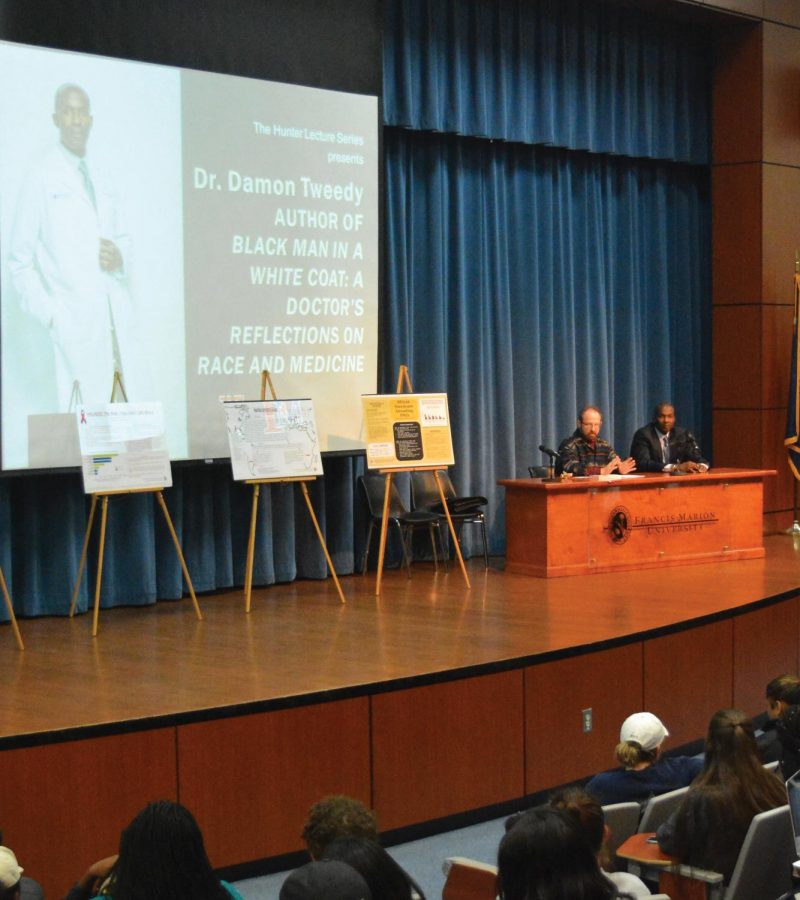Three-part symposium discusses race relations
Photo by: Caleb Reeves
Smolen-Morten interviews Dr. Damon Tweedy about his book. Dr. Damon Tweedy invites students to ask questions about race relations and his life’s work. Tweedy’s book was the common text for English 102 this semester.
Dr. Damon Tweedy visited FMU to discuss his book “Black Man in a White Coat” in a three-part series on March 14 in Chapman Auditorium. The FMU English department, Ready to Experience Applied Learning (REAL) Program, School of Health Sciences, Hunter Fund and the South Carolina Humanities Council sponsored the common text colloquium, student poster and panel session and the Hunter Chair in English Literature lecture.
Shawn Smolen-Morton, associate professor of English, was responsible for arranging Tweedy’s visit and organizing the colloquium and lecture events. Smolen-Morton said inviting Tweedy to the lecture segment of the day’s events is what the department always does for the author(s) of the common text for that semester, because it enhances the lecture when students are familiar with the speaker’s work. According to Smolen-Morton, the English department and the committees within it decide on the text from a list of 30-40 books suggested by faculty.
Smolen-Morton said the colloquium event is not always coupled with the lecture event, but they are arranged together when the common text and its author are expected to gather a large reception. Additionally, Smolen-Morten said Tweedy encouraged students who attended the colloquium to email him questions.
The colloquium event began with Smolen-Morton asking Tweedy questions about what inspired him to write the book and if he sees similar racial issues today as those in the book. Afterward, the discussion was opened for explanations of certain topics and chapters contained in the book. Attendees asked questions and Tweedy offered advice for those who face similar prejudice.
Tweedy said he decided to write the book because of certain issues not being handled adequately.
“I’d written some articles and received a lot of feedback that was really personal and touching, and people wanted to read them and talk about them,” Tweedy said. “I got some letters from patients as well as doctors in response to articles I’d written, and I said, ‘There’s something really here that I need to discuss.’”
Rachel Spear, assistant professor of English, was involved with the committees that decided on the common text. Spear oversaw the student poster and panel session, which was comprised of four students presenting research on topics they had gleaned from Tweedy’s book.
“This poster and panel session was something extra for them, outside of their normal classes and part of an applied learning experience funded by FMU’s REAL program,” Spear said. “We opened up this opportunity to our English 102 students in conjunction with the composition common read, inviting students to submit a research proposal for this chance to practice their compositional and communication skills. These four students were selected and paired with faculty mentors to do so.”
The poster and panel session was opened for questions after the four students had presented and discussed their research: “Dangers of Drinking While Pregnant” by Courtney Allen, “HIV/AIDS: The Risks They Don’t Talk About” by Morgan Kephart, “How Race Correlates to Disease” by Luis Mendoza and “African-Americans Attending PWIs” by Patience Pinckney.
Amy Lea Clemons, assistant professor of English, said the session was an opportunity for these four students to recognize the connection between their classes and real-world applications of their education.
Spear said the interdisciplinary links in Tweedy’s book allowed for greater reception and adoption of the common text among different departments, particularly with the health sciences school and the nursing program. According to Spear, this aspect of Tweedy’s book was one reason why it was selected as the common text, as the selection should be appealing to most departments since it is not required. Spear said as a result, they had 11 English faculty opt to adopt the common text, totaling 23 sections of composition courses.
Dean of School of Health Sciences Ruth Wittmann-Price said the events associated with Tweedy’s book were valuable opportunities for students.
“The main objective for nursing was to have this presentation as a piece in the Nursing Workforce Diversity grant which funds 100 high-risk freshmen pre-nursing students,” Wittmann-Price said. “Professional conference attendance is a method to have them incorporate professional values and different perspectives into their lives and eventually the lives of their patients.”
The lecture event began after the poster and panel session with Tweedy giving some background information about his life and work. Students then asked questions about the inspiration for his book and how to handle modern examples of issues he discussed during the lecture.
Tweedy said he had some worries about responding to questions and feedback about his book.
“I worried about it,” Tweedy said. “I deliberately started talking about my own limitations and prejudices as a starting point, so it wasn’t a position of ‘I’m attacking you’ because we all have these problems and this is my side of the story.”
